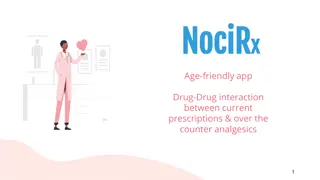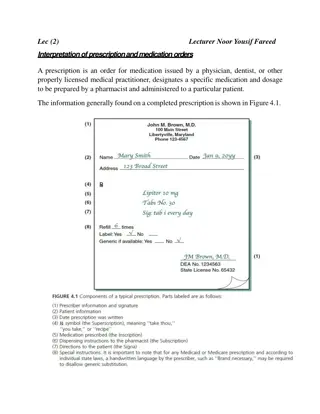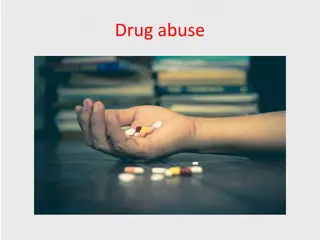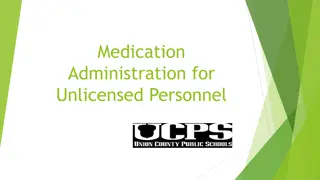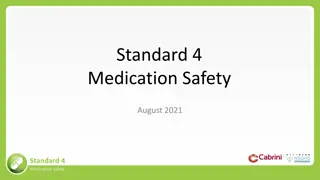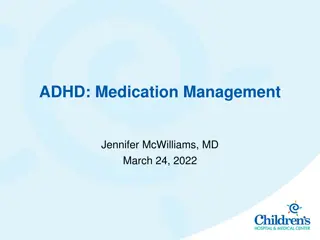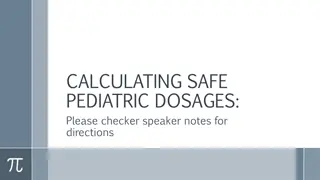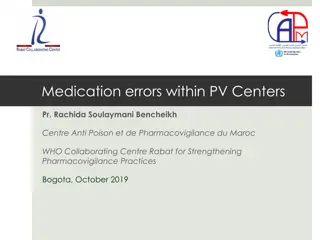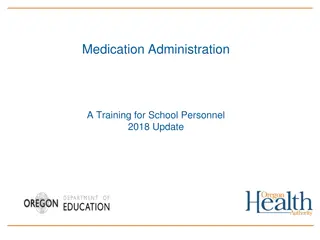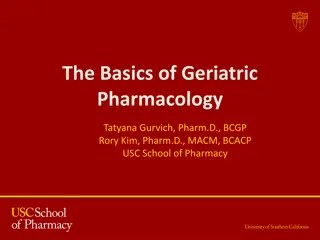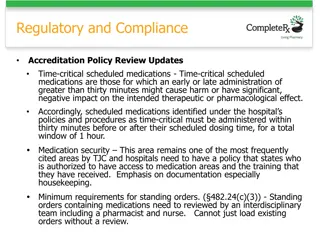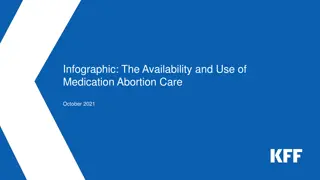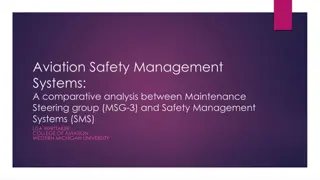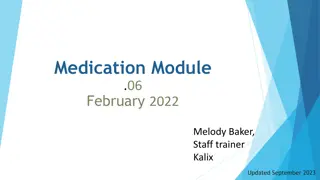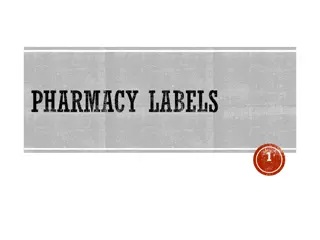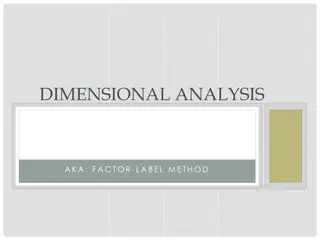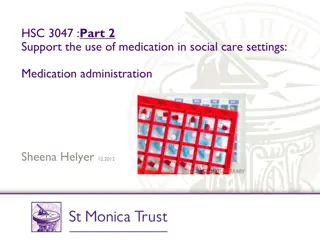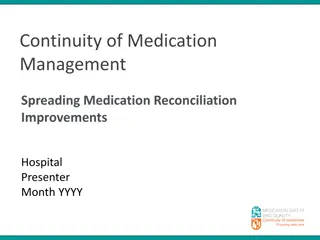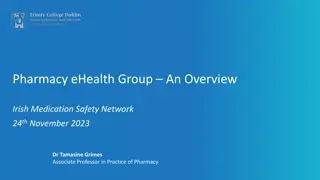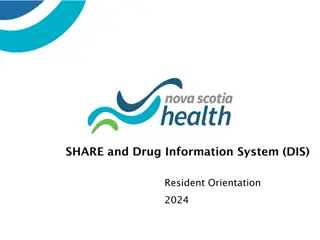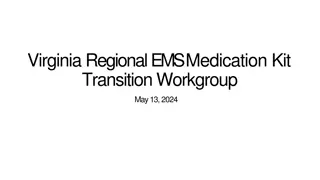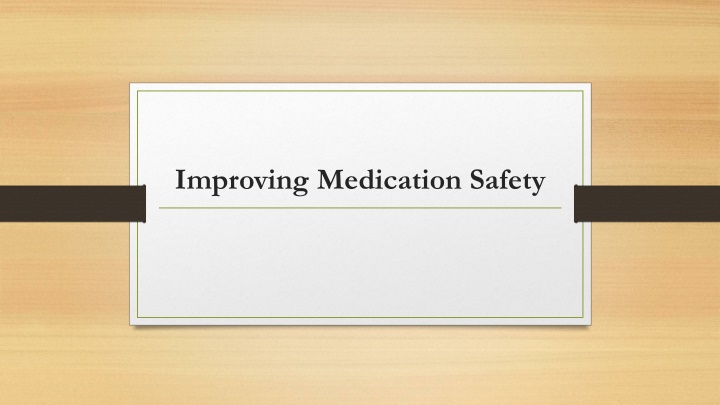
Medication Safety to Enhance Patient Care
Explore the impact of medication errors on healthcare and strategies to improve medication safety. Learn about various types of medication errors, their consequences, and ways to prevent them, ultimately aiming to enhance patient well-being and reduce healthcare costs.
Download Presentation

Please find below an Image/Link to download the presentation.
The content on the website is provided AS IS for your information and personal use only. It may not be sold, licensed, or shared on other websites without obtaining consent from the author. If you encounter any issues during the download, it is possible that the publisher has removed the file from their server.
You are allowed to download the files provided on this website for personal or commercial use, subject to the condition that they are used lawfully. All files are the property of their respective owners.
The content on the website is provided AS IS for your information and personal use only. It may not be sold, licensed, or shared on other websites without obtaining consent from the author.
E N D
Presentation Transcript
Learning objectives To provide an overview of Medication Safety To encourage students to learn and practice ways to improve the safety of medication use
Introduction The Institute of Medicine's 1999 report suggested that medical errors accounted for 44,000-98,000 deaths each year.These deaths exceed the eighth leading cause of death in the United States. It is estimated that the total cost of medical errors is $17 billion-$29 billion annually. The drugs errors are the most common cause of medical errors in hospitals, affecting 3.7% of patients. Clearly, medication errors are a significant component of medical errors in U.S. hospitals. Institute of Medicine. To err is human: building a safer health care system. Washington, D.C.: National Academy Press, 1999. Brennan TA, Leape LL, Laird NM, et al. Incidence of adverse events and negligence in hospitalized patients. N Engl J Med 1991;324:370-6. Johnson WG, Brennan TA, Newhouse JP, et al. The economic consequences of medical injuries. JAMA 1992;267:2487-92. Leape LL, Brennan TA, Laird NM, et al. The nature of adverse events in hospitalized patients. N Engl J Med 1991;324:377-84.
Introduction Hospital medication errors occur in 3-6.9% of inpatients. One analysis determined that 11% of medication errors in hospitals were pharmacy dispensing errors related to the wrong drug or strength. Nelson KM, Talbert RL. Drug-related hospital admissions. Pharmacotherapy 1996:16(4):701-7. Bates DW, Boyle DL, Vander VM, et al. Incidence of adverse drug events and potential adverse drug events: implications for prevention. JAMA 1995;274:29-34.
Introduction The study population consisted of 1116 hospitals that reported information on medication errors shows : Medication errors occurred in 5.07% of the patients admitted each year to these hospitals Each hospital experienced a medication error every 22.7 hours (every 19.73 admissions). Medication errors in United States hospitals. Bond CA1, Raehl CL, Franke T. Pharmacotherapy. 2001 Sep;21(9):1023-36.
Definitions Medication Error: is any preventable event that may cause or led to inappropriate medication use or patient harm. Adverse Drug Event: harm experience by a patient as a result of medication it includes both errors & side effect of the medication. Adverse reaction: unexpected harm arising from a justified action where the correct process was followed forth context in which the event occurred e.g. an unexpected allergic reaction in a patient taking a medication for the first time Near Miss: incidence about to happen but by chance didn t occur.
Categorizing Medication Errors 2001 National Coordinating Council for Medication Error Reporting and Prevention.
Medication Use Process in The Institutional Setting 1. Prescription 2. Transcription 3. Preparation and Dispensing 4. Administration 5. Monitoring
Sources of error in prescribing: Documentation - illegible, incomplete, ambiguous & dangerous abbreviation Inadequate knowledge about drug indications and contraindications Not considering individual patient factors, such as allergies ,pregnancy, co- morbidities, other medications Wrong patient, wrong dose, wrong time, wrong drug, wrong route Inadequate communication (written, verbal) Mathematical error when calculating dosage
Strategies to Reduce Prescribing errors Write Complete Information: Patient s Name Patient-Specific Data Generic and Brand Name Drug Strength Dosage Form Amount Directions for Use Purpose Refills Avoid Illegible Handwriting: Write/Print More Carefully Use Computers Verbal Communications
Strategies to Reduce Prescribing errors Look at Patient-Specific Information Age Weight Renal and Hepatic Function Laboratory Test Results Concurrent Medications Allergies Medical/Surgical/Family History Pregnancy/Lactation Status Do Not Use Abbreviations Drug names QD or OD for the word daily Letter U for unit g for microgram (use mcg) QOD for every other day
Strategies to Reduce Prescribing errors Decimals: Avoid whenever possible Use 500 mg for 0.5 g Use 125 mcg for 0.125 mg Never leave a decimal point naked Haldol .5 mg Haldol 0.5 mg Never use a terminal zero Colchicine 1 mg not 1.0 mg Space between name and dose Inderal40 mg Inderal 40 mg Be alert to Drug Name: Look-Alike or Sound-Alike Drug Names Celebrex (celecoxib, anti-inflammatory); Cerebryx (fosphenytoin, anticonvulsant); Celexa (Citalpram,antidepressant)
Strategies to Reduce Prescribing errors More Attention to Dosage Calculations: Use patient-specific information height weight age body system function Write the Medication Reconciliation Learn and practice thorough medication history taking: Include name, dose, route, frequency and duration of every drug the patient is taking; Enquire about recently ceased medications; Ask about over-the-counter medications, dietary supplements and complimentary medicines;
Strategies to Reduce Prescribing errors Verbal Orders: Avoid when possible Enunciate slowly and distinctly State numbers like pilots (i.e., one-five mg for 15 mg) Spell out difficult drug names Specify concentrations Know the High Alert Medications: Need double check Example : Oral anticoagulants Insulin Chemotherapeutic agents Neuromuscular blocking agents Concentrated electrolytes Emergency medications (potent and used in high pressure situations)
Strategies to Reduce Prescribing errors Institutional responsibilities: Standardized dosing protocol (Vancomycin for Pediatric & Adult ) Use standard abbreviations Use CPOE and decision support framework Conduct FMEA
Dispensing Process Errors Prevention: 1. Standardized concentrations for all IV medication 2. Use commercially prepared solutions 3. Dispense a unit of use
Administration Process Errors Prevention: 1. Be familiar with the institution policy 2. Preprinted & standardized infusion rate charts 3. Use programmable infusion device 4. Infusion tubing should be traced from the infusion bag to the point of delivery
Calculation errors Can you answer the following question? A patient needs 300 micrograms of a medication that comes in a 1 ml ampoule containing 1 mg of the drug. What volume do you draw up and inject?
Types of errors in monitoring: Inadequate monitoring for side-effects; Medication not ceased once course is complete or clearly not helping the patient; Course of prescribed medication not completed; Drug levels not measured, or measured but not checked or acted upon; Communication failures this is a risk if the care provider changes, for example, if the patient moves from the hospital setting to the Community setting or vice versa.
Contributory Factors for Medication Errors Patient Factors Patients on multiple medications Patients with another condition, e.g. renal impairment, pregnancy Patients who cannot communicate well Patients who have more than one doctor Children and babies (dose calculations required?)
Contributory Factors for Medication Errors Staff Factors Inexperience Rushing Doing two things at the same time Interruptions Fatigue, boredom, or stress (IMSAFE) Lack of checking and double checking habits Poor teamwork and/or communication between colleagues
What are some of the ways to make medication use safer? Use generic names where appropriate Tailor prescribing to individual patients Know which medications are high-risk/high alert and take precautions Be very familiar with the medication you prescribe and/or dispense Use memory aids Remember the 5 Rs when prescribing and administering Develop checking habits Encourage patients to be actively involved in the process Report and learn from medication errors
Remember the 5 Rs when prescribing and administering Can you remember what they are? 1. Right Patient (check the name in the order & the patient, use two identifier & ask the patient to identify himself/herself). 2. Right Medication (check the medication label & order). 3. Right Route (Confirm that the patient can take or receive the medication by the ordered route) 4. Right Time (Check the frequency of the ordered medication & Confirm when the last dose was given). 5. Right Dose (Confirm appropriateness of the dose using a current drug reference & correct calculation)
Recommended actions: Pharmacists / Technician should READ / CHECK carefully the label of each medication they prepare. DOUBLE CHECKING is essential tool to avoid such mistakes Look Alike medications should be stored separately with proper labeling to avoid such mistakes To change the brand the hospital purchases of either drugs if possible
Case Study - 2 A 38-year-old woman comes to the hospital with 20 minutes of itchy red rash and facial swelling; she has a history of serious allergic reactions A nurse draws up 10 mls of 1:10,000 adrenaline (epinephrine) into a 10 ml syringe and leaves it at the bedside ready to use (1 mg in total) just in case the doctor requests it Meanwhile the doctor inserts an intravenous cannula The doctor sees the 10 ml syringe of clear fluid that the nurse has drawn up and assumes it is normal saline
Continue There is no communication between the doctor and the nurse at this time The doctor gives all 10 mls of adrenaline (epinephrine)through the intravenous cannula thinking he is using saline to flush the line. The patient suddenly feels terrible, anxious, becomes tachycardia and then becomes unconscious with no pulse She is discovered to be in ventricular tachycardia, is resuscitated and fortunately makes a good recovery Recommended dose of adrenaline (epinephrine) in anaphylaxis is 0.3 - 0.5 mg IM, this patient received 1mg IV
Can you identify the contributing factors to this error?
Can you identify the contributing factors to this error? Assumptions Lack of communication Inadequate labeling of syringe Giving a substance without checking and double checking what it is Lack of care with a potent medication
How could this error have been prevented? Never give a medication unless you are sure you know what it is; be suspicious of unlabeled syringes Never use an unlabeled syringe unless you have drawn the medication up yourself Label all syringes Communication - nurse and doctor to keep each other informed of what they are doing e.g. nurse: I m drawing up some adrenaline Develop checking habits before administering every medication go through the 5 Rse.g doctor: What is in this syringe?
Summary Medications can greatly improve health when used wisely and correctly Yet, medication error is common and is causing preventable human suffering and financial cost Remember that using medications to help patients is not a risk-free activity Know your responsibilities and work hard to make medication use safe for your patients

